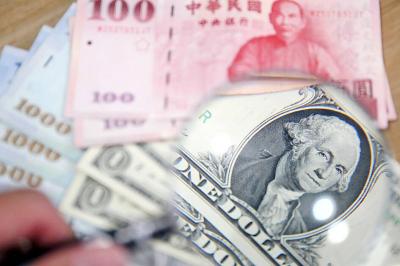Every credible plan to save humanity from global warming reserves a key role for a green energy technology called carbon capture and storage (CCS).
However, there is a problem: No one has figured out a viable way to pay for it.
Usually just called CCS, the technology can take carbon dioxide — the dominant greenhouse gas — from major pollution sources like power plants or steel mills and pump it deep underground, out of harm’s way.

Photo: Reuters
CCS is crucial to many scenarios — including from the UN’s climate science panel — for keeping global warming under 2oC, considered the redline for catastrophic climate impacts.
However, despite decades of testing, only a handful of the projects are actually in service.
One of the main reasons, experts say, is a very hefty price tag that has kept nervous investors at bay.
“There are 22 large-scale [CCS] operations in the world,” said Isabelle Czernichowski-Lauriol, president emeritus of CO2GeoNet, a European research network.
“We need to have over 1,000,” she said. “There has been a delay in regards to what was expected, but it has mostly been due to the lack of an economic model.”
Catching, transporting and storing just a fraction of the world’s carbon emissions would require the construction of a massive new industry.
CCS works by compressing gaseous carbon dioxide into a liquid form and pumping it into the ground.
Scientist and analyst Vaclav Smil, a respected voice on environmental and energy matters, has calculated that a CCS infrastructure — to capture and store 20 percent of the world’s carbon dioxide from burning fossil fuels — would need a capacity 70 percent larger than the petroleum flow handled by the global crude oil industry.
The scale of effort needed for any substantial reduction of emissions and the operating costs “combine to guarantee very slow progress,” he wrote.
At the moment, Canada’s Boundary Dam power station in Saskatchewan is the world’s only commercial-scale coal-fired power plant that uses carbon capture to keep its emissions out of the air.
It is designed to grab 90 percent of the plant’s carbon dioxide gases — the equivalent of the pollution from 250,000 cars — which are then sold and pumped to nearby facilities for use in squeezing oil out of the ground.
Sale of the gas provides extra revenue for the station, which cost C$1.5 billion (US$1.12 billion) to build. About one-sixth came from government subsidies.
“Cost is one of the main barriers to CCS,” London School of Economics and Political Science policy analyst Samuela Bassi said. “Building these plants is expensive.”
Adding carbon capture technology to coal-fired power plants pushes up their cost by between 40 and 80 percent, and by up to 50 percent for natural gas-burning stations.
One reason carbon capture is so expensive is the technology is relatively new as a climate change solution — about a decade old — and some of the projects are one-of-a-kind.
A developing technology without a proven, viable business model is also seen as risky by investors, driving up the cost of borrowing money, analysts said.
Further handicapping CCS, a lot of government subsidies — and regulatory support — are going to competing technologies such as wind and solar.
“For CCS, you don’t yet have this type of system in place, except in the UK,” Bassi said. “But in the rest of the world you don’t have that kind of economic support.”
Analysts say the cost of CCS-equipped power plants will come down significantly as more projects get built and the technology is refined.
However, just two carbon capture-equipped, industrial-scale power plants — both in the US — are due to come online next year, and there are a dearth of big projects on the drawing board.
There are 22 large-scale CCS projects that are either in operation or are slated to be up and running by 2017.
Another 23 big projects currently in various stages of development are “maybes,” according to a spokesman for the Global Carbon Capture and Storage Institute, an industry group.
That total number of industrial-scale projects — 45 — is an 18 percent decrease over the 55 listed in the institute’s report for last year.
EU targets have called for the equivalent of 11 large-scale, CCS-equipped power plants by 2030, which would cost up to 35 billion euros (US$40 billion), according to the Grantham Research Institute on Climate Change and the Environment.
So far 1.3 billion euros in public funds have been, or are being, spent on developing these projects.

The US dollar was trading at NT$29.7 at 10am today on the Taipei Foreign Exchange, as the New Taiwan dollar gained NT$1.364 from the previous close last week. The NT dollar continued to rise today, after surging 3.07 percent on Friday. After opening at NT$30.91, the NT dollar gained more than NT$1 in just 15 minutes, briefly passing the NT$30 mark. Before the US Department of the Treasury's semi-annual currency report came out, expectations that the NT dollar would keep rising were already building. The NT dollar on Friday closed at NT$31.064, up by NT$0.953 — a 3.07 percent single-day gain. Today,

‘SHORT TERM’: The local currency would likely remain strong in the near term, driven by anticipated US trade pressure, capital inflows and expectations of a US Fed rate cut The US dollar is expected to fall below NT$30 in the near term, as traders anticipate increased pressure from Washington for Taiwan to allow the New Taiwan dollar to appreciate, Cathay United Bank (國泰世華銀行) chief economist Lin Chi-chao (林啟超) said. Following a sharp drop in the greenback against the NT dollar on Friday, Lin told the Central News Agency that the local currency is likely to remain strong in the short term, driven in part by market psychology surrounding anticipated US policy pressure. On Friday, the US dollar fell NT$0.953, or 3.07 percent, closing at NT$31.064 — its lowest level since Jan.

The New Taiwan dollar and Taiwanese stocks surged on signs that trade tensions between the world’s top two economies might start easing and as US tech earnings boosted the outlook of the nation’s semiconductor exports. The NT dollar strengthened as much as 3.8 percent versus the US dollar to 30.815, the biggest intraday gain since January 2011, closing at NT$31.064. The benchmark TAIEX jumped 2.73 percent to outperform the region’s equity gauges. Outlook for global trade improved after China said it is assessing possible trade talks with the US, providing a boost for the nation’s currency and shares. As the NT dollar

The Financial Supervisory Commission (FSC) yesterday met with some of the nation’s largest insurance companies as a skyrocketing New Taiwan dollar piles pressure on their hundreds of billions of dollars in US bond investments. The commission has asked some life insurance firms, among the biggest Asian holders of US debt, to discuss how the rapidly strengthening NT dollar has impacted their operations, people familiar with the matter said. The meeting took place as the NT dollar jumped as much as 5 percent yesterday, its biggest intraday gain in more than three decades. The local currency surged as exporters rushed to